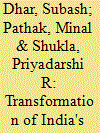|
|
|
Sort Order |
|
|
|
Items / Page
|
|
|
|
|
|
|
| Srl | Item |
| 1 |
ID:
090079


|
|
|
|
|
| Publication |
2009.
|
| Summary/Abstract |
Electricity sector is among the key users of natural gas. The sustained electricity deficit and environment policies have added to an already rising demand for gas. This paper tries to understand gas demand in future from electricity sector. This paper models the future demand for gas in India from the electricity sector under alternative scenarios for the period 2005-2025, using bottom-up ANSWER MARKAL model. The scenarios are differentiated by alternate economic growth projections and policies related to coal reforms, infrastructure choices and local environment. The results across scenarios show that gas competes with coal as a base-load option if price difference is below US $ 4 per MBtu. At higher price difference gas penetrates only the peak power market. Gas demand is lower in the high economic growth scenario, since electricity sector is more flexible in substitution of primary energy. Gas demand reduces also in cases when coal supply curve shifts rightwards such as under coal reforms and coal-by-wire scenarios. Local environmental (SO2 emissions) control promotes end of pipe solutions flue gas de-sulfurisation (FGD) initially, though in the longer term mitigation happens by fuel substitution (coal by gas) and introduction of clean coal technologies integrated gasification combined cycle (IGCC).
|
|
|
|
|
|
|
|
|
|
|
|
|
|
|
|
| 2 |
ID:
115652


|
|
|
|
|
| Publication |
2012.
|
| Summary/Abstract |
Electricity production causes unintended impacts. Their exclusion by the market leads to suboptimal resource allocations. Monetizing and internalizing of external costs, though challenging and debatable, leads to a better allocation of economic resources and welfare. In this paper, a life-cycle analysis (LCA) on the production of electricity from conventional coal based electricity generation system has been performed in order to examine the environmental impacts of coal based electricity generating systems in the twin-city of Ahmedabad and Gandhinagar in western India. By using dose-response functions, we make an attempt to estimate the damages to human health, crops, and building materials resulting from the operation of coal power plants and its associated mines. Further, we use geographic information system to account for spatially dependent data. Finally, monetary values have been assigned to estimate the damage to human health, crops and building materials. This study reveals that the health as well as on non-health impacts of air pollution resulting from coal based electricity generation may not be ignored both in absolute as well as economic value terms.
|
|
|
|
|
|
|
|
|
|
|
|
|
|
|
|
| 3 |
ID:
171414


|
|
|
|
|
| Summary/Abstract |
The anticipated economic and population growth in India will increase demand for material resources, energy and consequently carbon emissions. The global ambition to limit global warming to 1.5 °C by the end of the century calls for rapid and unprecedented action. As the most carbon-intensive sectors, India's steel and cement industry will require a more transformative shift, both on the demand and supply side.
Strategies from both supply and demand-side are analysed for steel and cement sector to understand consequences for energy and emissions using two modelling approaches i) energy system and ii) material flow models. A portfolio of technically feasible options to reduce the material, energy and CO2 intensity is explored under four alternate scenarios spanning till 2050 differentiated by their mitigation ambition and development paradigm.
Results show that current policies in India will provide adequate incentives for achieving the climate targets India has submitted within its Nationally Determined Contribution (NDC) however, dematerialisation, reuse and recycling will be necessary for achieving the global ambition of 1.5 °C. The study concludes that a stringent carbon policy in combination with strong sustainability principles can reduce CO2 emissions by 68% in the steel and cement sector in 1.5 °C Scenario compared to NDC Scenario.
|
|
|
|
|
|
|
|
|
|
|
|
|
|
|
|
|
|
|
|
|